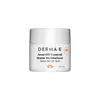What's inside
What's inside
 Key Ingredients
Key Ingredients

 Benefits
Benefits

 Concerns
Concerns

 Ingredients Side-by-side
Ingredients Side-by-side

Salicylic Acid 0.53%
MaskingWater
Skin ConditioningStearic Acid
CleansingCaprylic/Capric Triglyceride
MaskingCetyl Alcohol
EmollientGlyceryl Stearate Citrate
EmollientMelaleuca Alternifolia Leaf Oil
AntioxidantGlycerin
HumectantPolysorbate 60
EmulsifyingSalix Alba Bark Extract
AstringentAniba Rosodora Wood Oil
AstringentSimmondsia Chinensis Seed Oil
EmollientChamomilla Recutita Flower Extract
MaskingAloe Barbadensis Extract
Skin ConditioningAllantoin
Skin ConditioningPanthenol
Skin ConditioningXanthan Gum
EmulsifyingPolysorbate 20
EmulsifyingGlyceryl Stearate
EmollientCetearyl Glucoside
EmulsifyingPotassium Sorbate
PreservativePhenoxyethanol
PreservativeEthylhexylglycerin
Skin ConditioningLavandula Angustifolia Oil
MaskingSalicylic Acid 0.53%, Water, Stearic Acid, Caprylic/Capric Triglyceride, Cetyl Alcohol, Glyceryl Stearate Citrate, Melaleuca Alternifolia Leaf Oil, Glycerin, Polysorbate 60, Salix Alba Bark Extract, Aniba Rosodora Wood Oil, Simmondsia Chinensis Seed Oil, Chamomilla Recutita Flower Extract, Aloe Barbadensis Extract, Allantoin, Panthenol, Xanthan Gum, Polysorbate 20, Glyceryl Stearate, Cetearyl Glucoside, Potassium Sorbate, Phenoxyethanol, Ethylhexylglycerin, Lavandula Angustifolia Oil
Water
Skin ConditioningGlycerin
HumectantIsononyl Isononanoate
EmollientPropylene Glycol
HumectantAzelaic Acid
BufferingNiacinamide
SmoothingSqualane
EmollientAmmonium Polyacryloyldimethyl Taurate
Emulsion StabilisingCeramide AP
Skin ConditioningCeramide EOP
Skin ConditioningCeramide Eos
Skin ConditioningCeramide NP
Skin ConditioningCeramide Ns
Skin ConditioningSorbitan Isostearate
EmulsifyingBehenic Acid
CleansingCeteareth-25
CleansingSodium Hyaluronate
HumectantSodium Hydroxide
BufferingSilica Silylate
EmollientCholesterol
EmollientDipotassium Glycyrrhizate
HumectantHydrogenated Polyisobutene
EmollientHydroxyacetophenone
Antioxidant2-Hydroxyethyl Acrylate
Sodium Acrylate/Sodium Acryloyldimethyl Taurate Copolymer
Emulsion StabilisingCaprooyl Sphingosine
Skin ConditioningCaprylyl Glycol
EmollientEthylhexylglycerin
Skin ConditioningPolysorbate 60
EmulsifyingCetyl Alcohol
EmollientTocopherol
AntioxidantAscorbyl Palmitate
AntioxidantPhenoxyethanol
PreservativeWater, Glycerin, Isononyl Isononanoate, Propylene Glycol, Azelaic Acid, Niacinamide, Squalane, Ammonium Polyacryloyldimethyl Taurate, Ceramide AP, Ceramide EOP, Ceramide Eos, Ceramide NP, Ceramide Ns, Sorbitan Isostearate, Behenic Acid, Ceteareth-25, Sodium Hyaluronate, Sodium Hydroxide, Silica Silylate, Cholesterol, Dipotassium Glycyrrhizate, Hydrogenated Polyisobutene, Hydroxyacetophenone, 2-Hydroxyethyl Acrylate, Sodium Acrylate/Sodium Acryloyldimethyl Taurate Copolymer, Caprooyl Sphingosine, Caprylyl Glycol, Ethylhexylglycerin, Polysorbate 60, Cetyl Alcohol, Tocopherol, Ascorbyl Palmitate, Phenoxyethanol
 Reviews
Reviews

Ingredients Explained
These ingredients are found in both products.
Ingredients higher up in an ingredient list are typically present in a larger amount.
Cetyl Alcohol is a fatty alcohol. Fatty Alcohols are most often used as an emollient or to thicken a product.
Its main roles are:
Though it has "alcohol" in the name, it is not related to denatured alcohol or ethyl alcohol.
The FDA allows products labeled "alcohol-free" to have fatty alcohols.
Learn more about Cetyl AlcoholEthylhexylglycerin (we can't pronounce this either) is commonly used as a preservative and skin softener. It is derived from glyceryl.
You might see Ethylhexylglycerin often paired with other preservatives such as phenoxyethanol. Ethylhexylglycerin has been found to increase the effectiveness of these other preservatives.
Glycerin is already naturally found in your skin. It helps moisturize and protect your skin.
A study from 2016 found glycerin to be more effective as a humectant than AHAs and hyaluronic acid.
As a humectant, it helps the skin stay hydrated by pulling moisture to your skin. The low molecular weight of glycerin allows it to pull moisture into the deeper layers of your skin.
Hydrated skin improves your skin barrier; Your skin barrier helps protect against irritants and bacteria.
Glycerin has also been found to have antimicrobial and antiviral properties. Due to these properties, glycerin is often used in wound and burn treatments.
In cosmetics, glycerin is usually derived from plants such as soybean or palm. However, it can also be sourced from animals, such as tallow or animal fat.
This ingredient is organic, colorless, odorless, and non-toxic.
Glycerin is the name for this ingredient in American English. British English uses Glycerol/Glycerine.
Learn more about GlycerinPhenoxyethanol is a preservative that has germicide, antimicrobial, and aromatic properties. Studies show that phenoxyethanol can prevent microbial growth. By itself, it has a scent that is similar to that of a rose.
It's often used in formulations along with Caprylyl Glycol to preserve the shelf life of products.
Polysorbate 60 is used to help stabilize products. It is a surfactant and emulsifier. These properties help keep ingredients together in a product. Surfactants help reduce surface tension between ingredients with different states, such as liquids and solids. Emulsifiers help prevent oils and waters from separating.
Polysorbate 60 is sorbitol-based and created from the ethoxylation of sorbitan. Ethoxylation is a chemical reaction used to add ethylene oxide. Sorbitan is a the dehydrated version of sorbitol, a sugar found in fruits.
In this case, the 60 comes from reacting 60 units of ethylene oxide with sorbitan.
Polysorbates are commonly used in medicine and foods.
Learn more about Polysorbate 60Water. It's the most common cosmetic ingredient of all. You'll usually see it at the top of ingredient lists, meaning that it makes up the largest part of the product.
So why is it so popular? Water most often acts as a solvent - this means that it helps dissolve other ingredients into the formulation.
You'll also recognize water as that liquid we all need to stay alive. If you see this, drink a glass of water. Stay hydrated!
Learn more about Water